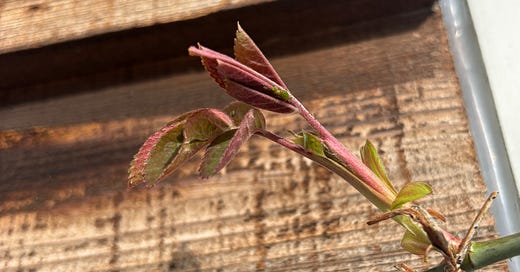How to save your plants from being ravaged by aphids (greenfly or blackfly)
5 tips you can action right away
Hi darling, I’m Kendall, a horticultural therapist. Here on my Substack, I share tips on how to use your garden to grow your personal power in a world that tries to keep women stuck, exhausted & burnt out. Come grab your trowel and join the rebellion, we’ve got a patriarchy to dismantle.
Welcome to the Seed, the place where we learn to resource ourselves in the garden so that we can unlock more joy in our lives.
As I grabbed 20 minutes for myself to prune my roses in peace last Sunday, I noticed the new growth sprouting was covered with those tell-tale bright-green fleshy bodies. Pissed off with the fact that the plant has barely had a chance to start growing, I knew I needed to take action.
So here’s 5 things I do in my garden to keep aphids (also known as greenfly or black fly) at bay.

Bin any chemical pest sprays
It’s tempting, as soon as you see something munching on your precious plants, to get the bug spray out and douse the plant in it. BUT the problem with those sprays are that they indiscriminately kill ALL insects, even the beneficial ones. And it’s the beneficial insects that are gonna be your allies in the fight against the aphids and ultimately save you time. You want to increase the biodiversity of your gardens so that natural predators of aphids, such as ladybirds, ground beetles, certain types of wasps and earwigs) come and do the hard work for you.
Don’t be too quick to tidy
So now you’ve made sure you’re not killing off the good gals, you need to make your garden as attractive as possible to beneficial insects. This looks like:
Leaving dead stems on your plants overwinter so the insects have somewhere to live and lay their eggs while the weather is cold.
Making sure you don’t cut the dead stems back in Spring until temps are above 10 degrees celsius and its warm enough for them to survive.
Creating a bug house or hotel or even mini log piles in various spots around your garden to provide shelter and food over winter.
Leaving weeds growing in your garden. I know all the books and the internet tell us that weeds are messy, but many beneficial insects actually rely on weeds as a food source in early spring before much else is flowering.

Seedlings, your extra 3 tips are behind the paywall below along with an audio version of this article for your convenience.
If you’re not yet in the Seed membership, come and join us for just £50 for the ENTIRE year! Imagine how good it would feel to commit to improving your wellbeing in the garden for a whole year with our support. You bloody deserve it!




